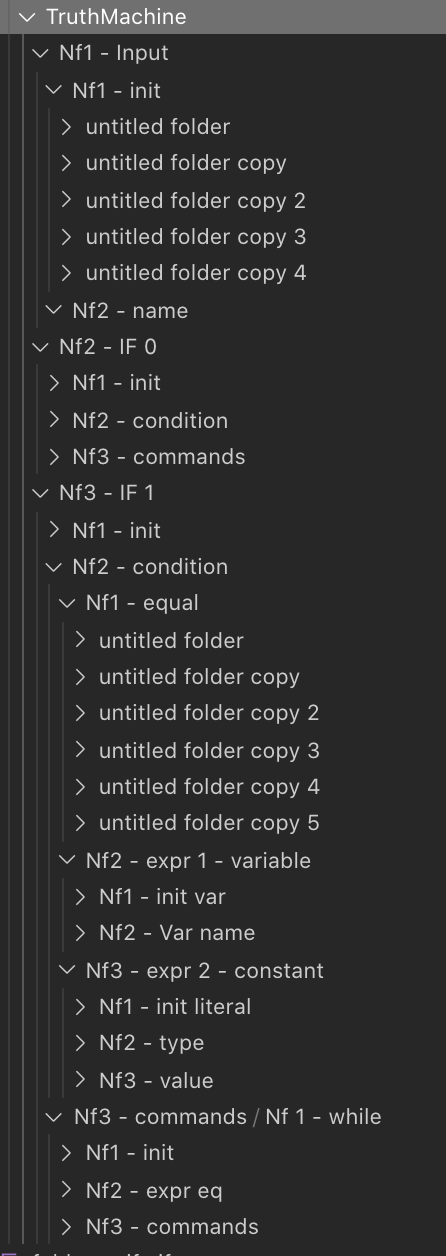Folders is an esoteric programming language, created by Daniel Temkin in 2015, which encodes the program entirely into the directory structure.
All names of the folders as well as their contents are completely ignored. Instead, the commands are encoded in the nesting of folders within folders.
Let me say that again: THE SOURCE CODE IS THE DIRECTORY STRUCTURE. Lol.
This is a Python implementation of Folders for all to enjoy!
Folders is (was originally) implemented in C#.
Simply install the Folders command line interpreter
pip install Folders
Give the folder of the program you wish to run as an command line argument
Folders sample_programs/HelloWorld
# => Hello, World!
If instead you would like list the Python code to stdout, use the -l option
Folders -l sample_programs/HelloWorld
# => print("Hello, World!", end='', flush=True)
The implementation is just the python file, folders.py and has no dependencies, so if you'd like you can clone the repo and run python ./folders/folders.py instead of pip installing and use it the same as in the examples above.
The language details are on the esolangs wiki, but I've put it here for reference.
For example, take a look at the Fibonacci sample program.
The root folder contains a list of command folders - in this case labelled Nf1.., Nf2.., but the names don't actually matter except the alphabetical ordering - the first folder (which I've labelled with an init) is the first "sub-folder", the next is the second, etc.
Commands take the following form
| Command | # of folders | Details |
|---|---|---|
| if | 0 folders | Second sub-folder holds expression, third holds list of commands |
| while | 1 folder | Second sub-folder holds expression, third holds list of commands |
| declare | 2 folders | Second sub-folder holds type, third holds var name (in number of folders, ex. zero folders becomes "var_0") |
| let | 3 folders | Second sub-folder hold variable name (in number of folders), third holds an expression |
| 4 folders | Second sub-folder holds expression | |
| input | 5 folders | Second sub-folder holds variable name |
Expression folders take the following form:
| Type | # of folders | Details |
|---|---|---|
| Variable | 0 folders | Second sub-folder holds variable name |
| Add | 1 folder | Second sub-folder holds the first expression to add, third holds second expression |
| Subtract | 2 folders | Second sub-folder holds the first expression to subtract, third holds second expression |
| Multiply | 3 folders | Second sub-folder holds the first expression to multiply, third holds second expression |
| Divide | 4 folders | Second sub-folder holds the first expression to divide, third holds second expression |
| Literal Value | 5 folders | Second sub-folder holds the type of the value (as described by types below, ex. two folders for a string) |
| Equal To | 6 folders | Second and third folders hold expressions to compare |
| Greater Than | 7 folders | Second and third folders hold expressions to compare (takes the form : second folder > third folder) |
And finally type folders take the following form:
| Type | # of folders |
|---|---|
| int | 0 folders |
| float | 1 folder |
| string | 2 folders |
| char | 3 folders |
The int, float, and char types are 8-bit only. But, you can add into their variables to arbitrary length, so to get a very large number you can simply multiply it a bunch of times.
This is what the fibonacci program does.
Behold, the mighty Truth Machine program:
All Folders programs are 0 bytes if you're on windows as it interprets an empty folder as 0 bytes.
The ultimate code golf!

